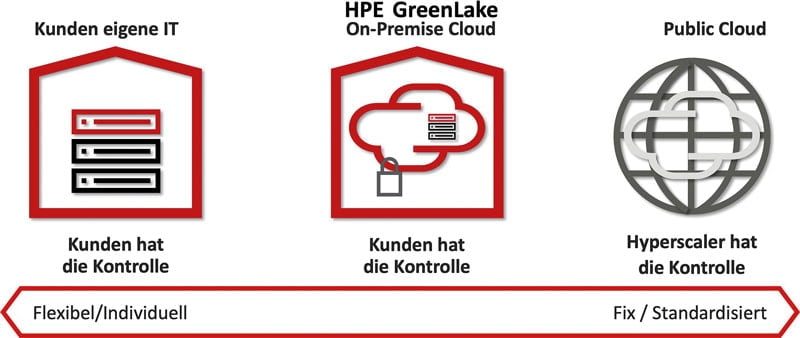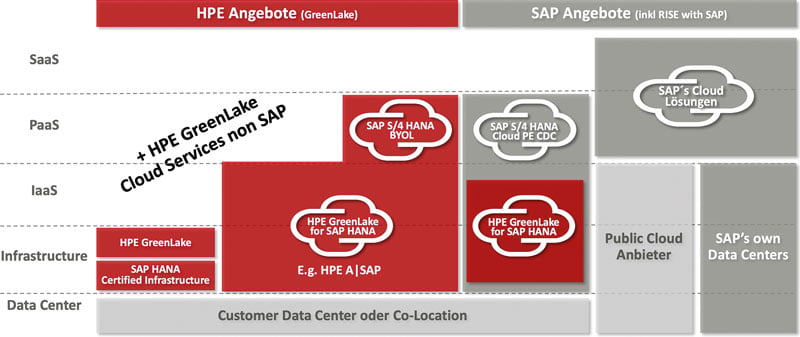

Demand for cloud-based SAP S/4 Hana remains hesitant in Germany
What looked like an either-or decision at the beginning turned out to be "the best of both worlds" in the course of an hour-long discussion. The topic is cloud functionality and S/4 Hana from one's own server, whereby it then remains open again where the S/4 Hana server is located - in one's own data center, with an outsourcer or hoster, or even with a specialized cloud provider. Anyone who wants to retain control over their own data and business processes should evaluate the architecture model from SAP and HPE.
Those who want to move their SAP applications to the cloud do not have to relocate ERP/ECC 6.0 and S/4 Hana to a remote cloud data center. The existing SAP customer can also continue to run their ERP in their own data center. The basis for this is on-prem cloud models such as HPE GreenLake. This architecture model offers the same advantages as the public cloud - such as simplicity, flexibility and consumption-based billing - but in the customer's data center or at another location of his choice. The systems are operated by HPE, up to app-base operation if desired.
Why this concept is another competitive advantage for the SAP community can be seen here in the free video stream be looked up. Discussing DSAG board member Sebastian Westphal, in his main job manager at Swiss Post Solutions in Frankfurt/M., Peter Gibbels, Head of Presales Enterprise Services SAP Hosting at Datagroup, and from HPE Albrecht Munz, Business Development Manager Data Solution, and Mike Wenner, Distinguished Technologist.
On-prem or cloud
In recent years, the discussion on cloud computing in the SAP community has often been reduced to either on-prem or cloud. However, there are also orchestrations from HPE in collaboration with SAP that bring together autonomy and self-determination with standard business software and cloud computing. Perhaps not easy at first glance, but the E-3 discussion has clearly shown that it is possible and also necessary: skepticism about cloud computing in the ERP environment is still high and, in addition, the supply of cloud-based infrastructure for SAP Hana is currently growing rapidly. Thus, further options for the software/infrastructure-as-a-service version S/4 have significantly changed the framework conditions for the changeover.
However, German companies in particular are still hesitant to switch to the cloud. Overall, the new comparative study "ISG Provider Lens SAP Ecosystem Report Germany 2022" published by the market research and consulting company Information Services Group (ISG) also reports that S/4 migrations are generally progressing only slowly. There is a great deal of uncertainty among German companies about the best approach to S/4 conversion. Many questions are currently being discussed in the SAP community: Is it a matter of a comprehensive revision of the process and system architecture? Should the transition to a cloud-based infrastructure be part of the S/4 conversion? And does the conversion of the applications have priority first, or first the migration to a new infrastructure?
When asked about the importance of SAP and non-SAP solutions, both on-prem and in the cloud, SAP on-prem solutions have a high and medium importance for the current IT landscapes at 93 percent of the DSAG member companies surveyed. For non-SAP on-prem solutions, this statement applies to 75 percent of the survey participants. As far as cloud solutions are concerned, non-SAP cloud solutions are of high and medium importance for 61 percent, while the figure for SAP cloud solutions is only 42 percent. Many existing SAP customers still see the advantages of their own, individual IT. The arguments cited for this are transparency, control over their own data center, and the fact that the total costs of external solutions are sometimes difficult to plan. Consequently, users are currently discussing the extent to which it makes sense to run their own data center or whether the core IT process can and should be outsourced in whole or in part to a cloud environment.

The best of on-prem & cloud
SAP legacy customers who want to get the best of on-prem and cloud can transition the SAP environment to an on-prem cloud model with HPE GreenLake. There are basically two options: The existing SAP customer can do it with SAP or with HPE. However, the respective offerings differ considerably and it depends on IT strategy, history and other preferences which offering is right for which customer. The difference in a nutshell: GreenLake as part of the SAP offering is a fixed predefined infrastructure service. GreenLake direct from HPE offers significantly more flexibility and choice. Specifically, SAP uses the GreenLake concept for its S/4 Hana Cloud, Private Edition, Customer Data Center offering.
As can be seen from the name, this offer can only be used for S/4. The customer has no choice regarding hypervisors or management tools, nor can applications from other providers be run on this platform. HPE GreenLake is ordered from SAP and is part of the overall Rise contract. HPE is responsible for operating the IT infrastructure (IaaS) with GreenLake up to the hypervisor level. SAP operates the application services on top of this and acts as the overall contractor for the complete stack. On the other hand, GreenLake with HPE is the better solution for those who do not want to do without architecture adaptations and thus an individual SAP system, and who also want to use the same on-prem cloud platform for other applications.
Freedom of choice and autonomy seem to be important to many existing SAP customers, because when asked about the importance of software solutions for future IT landscapes, 85 percent of DSAG members attest high and medium relevance to SAP on-prem solutions. The ISG study also explicitly points out the problem of limited human resources. The rather moderate pace of S/4 conversion to date means that the number of SAP projects running in parallel in companies will increase significantly with a view to the end of 2027, when standard maintenance for the predecessor product ECC 6.0 is due to expire. Consolidated planning of the S/4 infrastructure thus appears to be the order of the day. The necessary number of know-how bearers with strategic and overall architectural vision must first be found or trained.
SAP's and HPE's offer seems all the more relevant if the DSAG survey is referred to once again: It is assumed that on-prem solutions will lose significance and cloud solutions will gain in importance - both in the SAP and non-SAP areas. The importance of SAP on-prem solutions will continue to decline, but will still remain at a high level. However, as SAP cloud solutions are becoming more important at the same time, this confirms the trend: the future is hybrid and the SAP existing customer is obviously demanding cloud functionality with the advantages of an on-prem infrastructure. In this context, it is important that SAP and partners such as HPE support existing SAP customers with correspondingly integrated and affordable scenarios based on adequate data models and processes.
Infrastructure Services
The GreenLake infrastructure service provided and operated by HPE is ordered from SAP within the Rise offering and is part of an overall contract. SAP in turn operates the application services of the existing customer on it and acts as the overall contractor for the complete stack. As the E-3 discussion showed, interest in such on-prem solutions is high and is confirmed not least by the survey conducted by the DSAG user association. According to their own statements, the majority of the companies surveyed are able to keep pace with the changes brought about by digitization, transformation and the changing times.
However, in terms of the importance of solutions now and in the future, the on-prem approach is still the undisputed leader. More transparency is what SAP's existing customers and the participants in the E-3 discussion want in terms of cloud contracts, roadmaps and product strategy. In addition, SAP must provide much better support for the complex transformation process.

With on-prem clouds, the rules of the game are changing. SAP legacy customers thus get the features of the cloud, but on their terms and under their control. The public cloud remains an important part of any IT mix, but now customers have an alternative. This also applies to the SAP application - the application, in other words, that controls the core business-critical processes in many companies and comprises the most important company data. Adopting a multi-cloud strategy is essential to the success of modern businesses.
It drives growth and innovation by increasing flexibility while meeting necessary security and compliance requirements. At the same time, there is an increasing need to consistently deploy, operationalize and manage applications across public and private clouds or at edge locations to manage exponentially growing complexity.
One thing is clear: there are no one-size-fits-all blueprints for application modernization. Enterprises need the freedom to choose the right cloud, software artifacts and services for the right application, tailored to their unique application needs. However, as enterprises expand to new cloud models and IaaS to leverage new services for themselves, multiple operating models are often in use simultaneously. Skill shortages and the resulting lack of resources, security, compliance and the complexity of managing operations across different on-prem and cloud architectures often develop into the biggest challenges.

The engine of digitization
The public cloud has been an important driver of digital transformation in recent years. With increasing use, users have also become increasingly aware of its downsides - for example, with regard to data sovereignty, latency and integration with in-house applications. Nor has the assumption that the public cloud is generally more cost-effective than in-house operation proved to be true, because flexibility has its price.
HPE GreenLake offers customers design freedom in many respects. For example, it is not necessary to migrate to S/4 to do so. The customer can move their existing ERP system to the GreenLake model and if they want to migrate, they can do so within that model. This also means that the customer can take their existing SAP modifications, databases, management tools, etc. into the GreenLake model. Another advantage is that the customer can also have other applications run in the same GreenLake environment - this can be useful, for example, if these applications are closely intertwined with the SAP system.
GreenLake also offers flexibility in terms of operational responsibility. If desired, HPE can take over responsibility including SLA agreements up to application base operation - but if the customer wants to do more under its own responsibility, it can also use HPE services only up to an arbitrarily defined level and coordinate them individually with HPE. In addition to operating services, HPE also offers a comprehensive portfolio of consulting, migration and integration services in the SAP environment.



